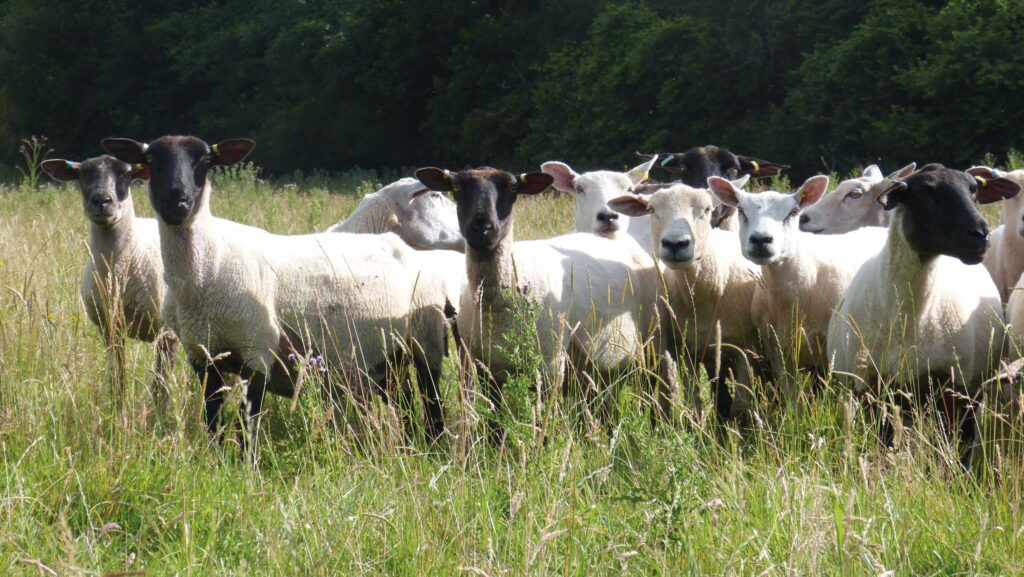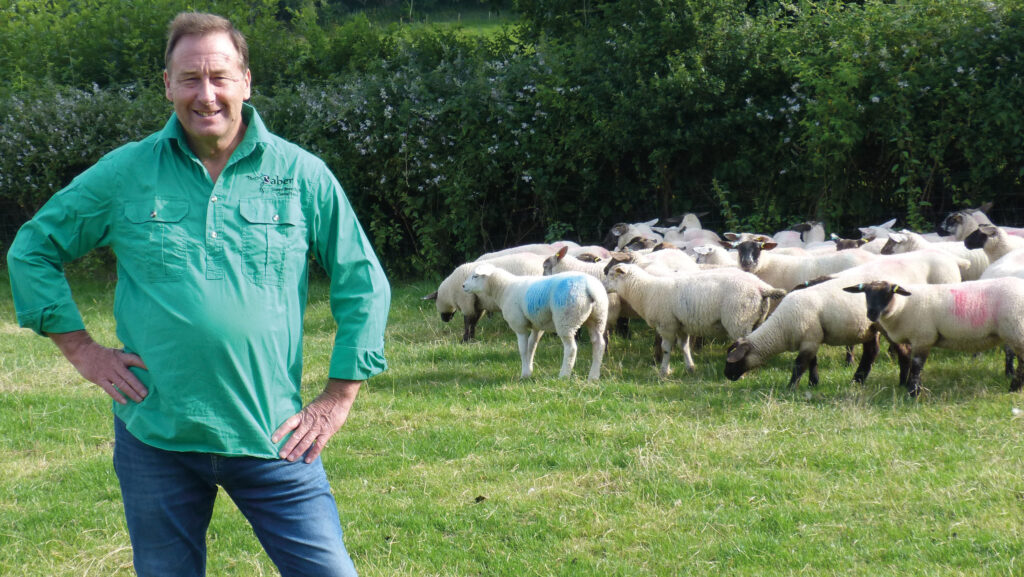How terminal sire stud is producing top 1% rams
 © MAG/Michael Priestley
© MAG/Michael Priestley Selecting high-index sheep in a challenging commercial system has resulted in sales of 100 terminal sire lambs a year with no hard feed for one Devon breeder.
Peter Baber and his wife, Louise, have been on a 35-year sheep breeding journey along which they have learnt important lessons about sheep functionality and the folly of rearing rams on hard feed.
Their ewes at Weir Park Farm, in Devon’s Teign Valley, are challenged to lamb outside and rear rams without creep feed.
See also: Why rest and recovery are essential for pasture after grazing
This means the weaning weights, recorded through Signet, are a true reflection of the ewes’ milking and maternal ability.
The only progeny to get compound fed are pet lambs, and these are sent to the abattoir.
Signet records for 2024 show the Babers’ sheep have achieved the following:
- 68% of Suffolk and SufTex lambs were in the top 1% of the recorded breed
- 86% were in the top 5%
- Exlana lambs now weigh 1.5kg more than in 2017 at weaning.
Farm facts Weir Park Farm, Christow, Devon
- 850 stud-breeding ewes: 600 Exlanas and 150 ewe lambs, plus 250 Suffolks/Texels and SufTexes and 80 ewe lambs
- Outdoor lambing
- Farming 160ha, with 20ha owned and the rest roughly half and half handshake grazing agreements or rented from family, including 20ha GS4 herbal leys
- All grassland classed as less favoured, much of it in an Environmentally Sensitive Area
- 100 shearling rams sold off farm privately a year

© MAG/Michael Priestley
Getting started
Peter grew up on a small livestock farm near Christow. On return from travelling in the 1980s, he began farming in his own right and has run a sheep-only system his entire career.
Originally, he took advantage of grazing lets with up to 20-odd landlords, grazing 1,200 commercial ewes, mostly Suffolk Mules.
He targeted the early spring lamb market and the conventional pedigree Suffolk market, lambing at Christmas with extensive use of artificial insemination, synchronised ovulation and creep feeding.
Peter’s big break came in 1987 when 40ha (99 acres) of low-lying grassland nearby was sold for golf course development. This gave him access to a decent-sized grazing block until Teign Valley Golf Course opened in 1995.
Changing system
He increasingly found bought-in rams he bought would “melt” when put to work on his farm, and often die after one or two winters.
He started to look at breeding his own rams, while still producing saleable lambs for prime and store markets and saving money in the process.
Having previously studied for a masters in beef production at Newcastle University and worked as a dairy cattle specialist with Adas, Peter understood the value of data in livestock breeding. He decided to breed Suffolks and Texels, as these were popular terminal sires.
He bought 10 females from the Pershore Texel flock dispersal sale in 1995, which made a great genetic base for his own flock: Texels were based on lesser-known flocks at the time and turned out to be less pampered and genetically superior, explains Peter.
The flocks were performance recorded with MLC (now Signet) from the outset, and were managed with a zero-tolerance policy to empties, prolapses, lambing assistance and lameness.
Peter adopted an increasingly commercial approach by making the following changes:
- Zero concentrates The importance of “breeding rather than feeding” was highlighted by a hugely disappointing high-index ram from another flock that consistently produced the worst lambs on the farm. By 1998, he had decided his own rams had to grow off forage.
- Shedding genetics The foot-and-mouth epidemic of 2001 prompted him to review flock cost structure. He bought four Easycare rams to develop a high-performance shedding sheep. He then joined several other like-minded breeders to develop the Exlana breed in 2006.
- Health status A sale of the commercial sheep took numbers from 1,200 to 400 ewes in 2004. Peter then tested everything for maedi visna (MV) twice, six months apart, and became MV accredited.
- Grass-based lactation In 2004, he opted to switch lambing to March and April to cut feed costs and turn out earlier.
- Crossbred tups The following year, he began marketing hybrid rams off farm based on their improved libido, fertility, hybrid vigour and longevity. Suffolks and Texels were crossed to create a SufTex. In addition, he worked with Signet to produce an index for these rams. Some rams are sold online just on estimated breeding values.
- Outdoor lambing By 2020, he trusted in his terminal sire genetics enough to lamb them outside after 30 years of recording for lambing ease, lamb vigour, lamb survival and birthweight. This has worked well.
Current system
A barn for 250 ewes sits by the farmhouse, built roughly in the centre of four blocks of land. This is used before shearing, and for rearing pet lambs and yarding jobs. Sheep are walked up to two miles along the lanes to grazing areas as needed.
“This makes grassland management tricky,” admits Peter. “If we had more control of grazing, I think we could do without concentrate feed full stop.
“As it is, we can get away without any concentrate for wintering most ewes most years.”
The Babers’ machinery inventory is minimal, comprising a pickup truck, a livestock trailer, two quad bikes, a quad bike trailer, an electronic weigh crate, a handling system and a telescope for faecal egg counts. Local contractors make haylage, which is manually pulled off square bales and trailered where it is needed in winter.
Summer grazing is mostly on low- or zero-input grassland. Herbal leys and forage rape undersown with Italian rygerass are used to finish lambs, winter ram lambs, and grow ewe lambs for tupping in their first autumn.
A 40ha (99-acre) area of ground near the M5 (30 miles away) is used as a quarantine area for incoming tups, with a separate area for wintering ram lambs on clean grazing.
Forage-reared rams cost £1 a lamb produced
Confidence in the Babers’ system has allowed commercial farmer Martin Chatfield, of Crossways Farm, Cheriton Bishop, Exeter, to buy rams unseen, for a cost of £1 a lamb produced.
Martin, who is in the process of retiring, bought Baber rams for 18 years, first trying Texel rams in 2006 and moving to SufTexes for their hybrid vigour.
Costing £600, the rams would comfortably sire 75 ewes a year for five breeding seasons in an outdoor lambing system. They would breed for two cycles, with ewes scanning at 160-165% and selling 150%.
This meant rams cost £1 a lamb produced. “If you factor in cull ram price at £120, it becomes 85p a lamb overall,” explains Martin, a first-generation farmer.
“I would ring Peter and ask for a ram or two, and he would drop them off. I trusted in him and the stock he produced. I didn’t need to see them.”
Martin devised a low-cost system based on 800 North of England Mule ewes supplying prime lambs to Waitrose. The system had to be low input, to run alongside Martin’s truck-driving job. Ewes lambed outside in May and were wintered without concentrate feed.
